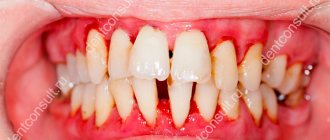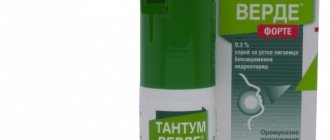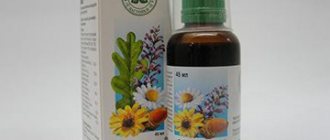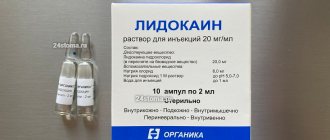Pharmacological properties of the drug Hexasprey
Antiseptic, analgesic, anti-inflammatory drug for topical use in otolaryngology, containing biclotymol (2,2-methylene-bis-(6-chlorothymol)). It is a phenol derivative with antibacterial activity against staphylococci, streptococci, micrococci and corynebacteria. The mechanism of action is due to the ability to coagulate proteins of microbial cells. In addition to antibacterial, it also has anti-inflammatory and local anesthetic effects. The drug is absorbed very slowly through the mucous membrane, which ensures its long-term presence in the oral cavity.
Additional components
The structure of Hexaspray aerosol is a suspension, yellowish and homogeneous with an anise aroma. The drug is available in a glass bottle with a volume of 30 g. The bottles are sold in cardboard packages.
Hexaspray includes:
- purified water;
- benzyl alcohol;
- disodium edetate;
- sodium saccharin;
- methylparaben;
- sodium carboxymethylcellulose;
- lecithin (soy type);
- glycerol;
- microcrystalline cellulose;
- ammonium glycyrrhizinate;
- ethanol 95%;
- anise oil
Special instructions for the use of Hexasprey
Using the drug for more than 5 days may cause disruption of the normal microflora of the oral cavity. The simultaneous use of other antiseptics should be avoided, since undesirable interactions (antagonism, inactivation) are possible. If the patient’s condition has worsened, in particular the body temperature has increased or there has been no improvement within 5 days, it is necessary to re-examine and change the treatment tactics. During pregnancy and breastfeeding. Adequate and well-controlled studies of the safety of the drug during pregnancy and breastfeeding have not been conducted.
Hexasprey aerosol for topical use 2.5% 30 g No. 1
Name
Hexasprey air.d/local.prim. 2.5% in fl 30g in pack No. 1
Description
A homogeneous suspension of white with a yellowish tint with a characteristic anise odor.
Main active ingredient
Biclotymol
Release form
Aerosol
Dosage
2,5%
special instructions
Keep the bottle upright during use. Shake the bottle before use. The therapy does not justify long-term treatment, especially since prolonged use of the drug for more than 5 days can disrupt the normal microflora of the mouth and throat with the risk of bacterial or fungal spread. If symptoms do not resolve within 5 days and/or are accompanied by fever, treatment should be reconsidered. The simultaneous or sequential use of antiseptics with biclotymol should be avoided, taking into account possible interactions (antagonism, inactivation). Soy lecithin may cause allergic reactions. The drug contains a small amount of alcohol, less than 100 mg per dose. Due to the content of methyl parahydroxybenzoate (E218), it can cause allergic reactions (including delayed ones).
Pharmacodynamics
Antimicrobial drug for topical use with antimicrobial effect. Biclotymol belongs to the class of biphenols. Biclotymol is active against gram-positive microorganisms under the following conditions: 15 minutes from contact to maximum concentration (900/0).
Pharmacokinetics
Unknown. Non-clinical safety data Not known.
Indications for use
The drug is indicated for the local treatment of infectious and inflammatory diseases of the mucous membrane of the oral cavity and pharynx, which are not accompanied by an increase in body temperature. If general signs of a bacterial infection occur, systemic antibiotics should be prescribed.
Directions for use and doses
Adults and children over 6 years of age: 2 sprays 3 times a day, regardless of meals. Treatment should be limited to 5 days.
Use during pregnancy and lactation
There is no reliable data on the teratogenic effect in animals. Clinically, no teratogenic effect or fetotoxicity effect has been demonstrated in women so far. However, monitoring of pregnant women exposed to biclotymol is not sufficient to exclude any risk. Therefore, as a precaution, it is preferable not to use biclotymol.
Interaction with other drugs
Avoid simultaneous use of other local agents.
Contraindications
Children's age up to 6 years. Hypersensitivity to the components of the drug.
Compound
Per bottle Active ingredients: Biclotymol 0.75 g Excipients: Benzyl alcohol 0.50 g Disodium edetate 0.0025 g Methyl parahydroxybenzoate (E218) 0.025 g Star anise oil 0.03 g Ammonium glycyrrhizinate 0.02 g Sodium saccharinate 0.05 g Avicel RC 591 (microcrystalline cellulose and sodium carmellose) 0.30 g Soy lecithin 0.90 g Glycerol 1.06 g Ethanol 96% 1.06 g Water 30.00 g
Overdose
No data on overdose
Side effect
During treatment with biclotymol, the following adverse reactions were observed, which are presented in accordance with the MedRA classification by body system and frequency of occurrence and are conventionally defined as follows: Very common (? 1/10) Frequent (? 1/100,
Storage conditions
At a temperature not exceeding 25 °C, out of the reach of children.
Indications and contraindications
The long-term effect of the drug, ensured by the slow absorption of active substances, reduces toxicity. This makes it possible for pregnant women with bacterial infections to inhale hexasprey. Hexaspray is prescribed for pregnant women for an inflammatory or infectious process that affects the oral cavity and nasopharynx.
To achieve a more lasting effect, it is recommended to take only minimal doses of the product. This does not reduce activity or effectiveness, but prolongs the period of action.
Indications for hexaspray during pregnancy:
- glossitis (inflammation of the tissues of the tongue, which is manifested by changes in structure and color);
- gingivitis (an inflammatory process in the gums that does not violate the integrity of the connections between the teeth and gums);
- periodontitis (inflammation of the periodontium, destroying the alveolar processes of the jaw);
- periodontitis (inflammation at the roots of teeth);
- candidal stomatitis (fungal inflammation of the oral cavity);
- ulcers and wounds of the mucous membrane;
- irritation or injury to soft tissues and mucous membranes when wearing braces and dentures;
- ENT diseases of an infectious or inflammatory nature (tonsillitis, laryngitis, pharyngitis, etc.);
- complication after tooth extraction or surgery;
- trauma during dental manipulation (gingivectomy, curettage, gingivoplasty).
Contraindications:
- age under 2 years (increased risk of laryngospasm);
- presence of allergies to components;
- hypersensitivity to biclotymol.
Analogues of hexaspray for pregnant women
The cost of hexaspray averages 250-300 rubles. The drug is available without a prescription at any pharmacy. If it is impossible to purchase the product, you can use its analogues. During pregnancy, the appropriateness of each drug should be discussed with your doctor.
Hexaspray analogues:
- Hexoral. The product provides an antiseptic, analgesic, antimicrobial, hemostatic, enveloping, deodorizing effect. The active substance is hexetidine. Like hexaspray, it destroys the walls of pathogenic microorganisms. The drug is available in the form of a solution and an aerosol. There is no evidence of the effect of hexoral on the fetus due to the difficulty of studying the effects of the components on the placenta and breast milk.
- Efizol. The drug has antifungal, antibacterial and antiseptic effects. Efizol is effective at alkaline pH. The active substance is dequalin chloride, bactericidal and fungistatic (stops the growth of fungi) quinoline. The drug is available in the form of lozenges. Use during pregnancy is permitted.
- Falimint. The remedy is more suitable for suppressing a non-productive cough. The analgesic effect is insignificant, in contrast to the antiseptic and antiemetic. Available in the form of dragees.
- Yox. The active ingredients of the drug are povidone-iodine and allantoin. The first gives a bactericidal, immunostimulating, mucolytic, proteolytic effect. The second reduces toxicity from iodine. Aerosol during pregnancy is used only if absolutely necessary.
- Inhalipt N. The product has an antibacterial, anti-inflammatory, cooling, and distracting effect. Active ingredients: soluble streptocide, sodium norsulfazole. Available in spray form.
- Strepsils Plus. Antifungal, antimicrobial, analgesic, anesthetic. The active substance 2,4-dichlorobenzyl alcohol has a bactericidal effect due to the dehydration of harmful microorganisms. Amylmethacreazole destroys protein in microbial cells. Strepsils is recommended for respiratory tract disease complicated by fungal infection. The drug is approved for breastfeeding.
- Grammidin. The effect of the drug is ensured by the antibiotic gramicidin. It enhances the permeability of bacterial walls. The advantage of the product is its effective effect on all pathogens of infections and inflammations of the oral cavity. During pregnancy, it should be taken only when absolutely necessary.
- Theraflu. Complex analgesic, antipyretic, decongestive, antiallergic drug. May produce a weak anti-inflammatory effect. The active substances are paracetamol, phenylephrine, pheniramine maleate. Available in powder form for solution. Pregnant women should take with caution.
- Bioparox. An inhalation analogue of hexaspray with fusafungine, which is a polypeptide antibiotic. The product gives a pronounced anti-inflammatory and bacteriostatic effect.
- Stopangin. Antimicrobial, antifungal, anti-inflammatory, enveloping agent. Contains hexetidine, methyl salicylate and natural oils. It is not advisable to take before the 14th week of pregnancy.
The minimal toxicity of hexaspray and its high efficiency make it possible to carry out antimicrobial therapy without harm to the fetus. The instructions for the drug contain an addition stating that the drug does not pose a risk to the pregnant woman and baby.
Sources used:
- Professional oral hygiene in modern dentistry / Oksana Almazovna Gulyaeva, Rais Timergaleevich Bulyakov und Tatyana Stepanovna Chemikosova. - M.: LAP Lambert Academic Publishing, 2014.
- Medicines in dentistry: monograph. / I.K. Lutskaya. - Moscow
- Medicines in dentistry. Directory / L.N. Maksimovskaya, P.I. Roshchina. - M.: Medicine, 2001.
Overdose and side effects
Judging by the reviews of patients, the use of hexaspray during pregnancy can result in different consequences. For some, the drug helps effectively, while others do not notice any effect. In most cases, hexaspray promotes pain relief, facilitates swallowing, and reduces body temperature.
Due to the lack of systemic absorption, the risk of overdose is minimized. In case of accidental ingestion of hexaspray, immediate gastric lavage is recommended. After the procedure, you need to take enterosorbents (activated carbon and others).
The use of hexaspray is rarely accompanied by unpleasant sensations. Most often, the drug provides pain relief in the near future after use.
Many patients report an effect within five days of therapy for oral infections. A small percentage of women experience negative side effects: nausea, swollen lips, increased salivation, erythema (dilation of capillaries causing severe redness of the skin), rash, urticaria, Quincke's edema (rare).










